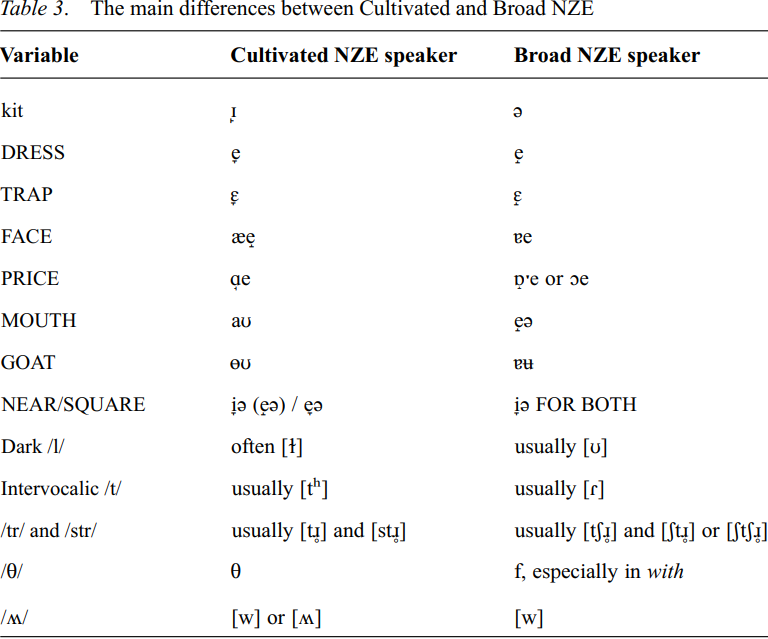


 Grammar
Grammar
 Tenses
Tenses
 Present
Present
 Past
Past
 Future
Future
 Parts Of Speech
Parts Of Speech
 Nouns
Nouns
 Verbs
Verbs
 Adverbs
Adverbs
 Adjectives
Adjectives
 Pronouns
Pronouns
 Pre Position
Pre Position
 Preposition by function
Preposition by function 
 Preposition by construction
Preposition by construction
 Conjunctions
Conjunctions
 Interjections
Interjections
 Grammar Rules
Grammar Rules
 Linguistics
Linguistics
 Semantics
Semantics
 Pragmatics
Pragmatics
 Reading Comprehension
Reading Comprehension|
Read More
Date: 2-4-2022
Date: 2024-02-20
Date: 2024-03-23
|
Differences because of social class are clearly identifiable in present-day NZE. The three young women in the accompanying audio clip were selected in terms of social class. Karen is from a middle social class, Christine from a lower social class and Wendy from a higher social class. However, the recordings can be clearly differentiated linguistically as can be heard in the accompanying audio clip. Wendy speaks Cultivated NZE, Karen General NZE and Christine Broad NZE. The letter they are reading is widely used in investigations of NZE. It contains most of the key vowels in stressed position. The text is given in Table 2.

Social class is marked most clearly by the pronunciation of the closing diphthongs, FACE, PRICE, GOAT and MOUTH, with women from higher social classes in particular avoiding pronunciations associated with lower social classes. The front vowels, KIT, DRESS and TRAP and the centring diphthongs NEAR and SQUARE also receive different pronunciations from different social groups. The consonant that shows social class differentiation most clearly is /θ/, which is fronted, so that think is pronounced /fɪŋk/ by many speakers from lower social classes. TH-fronting is overtly stigmatized by those who speak Cultivated NZE, and speakers from the higher social classes avoid it. Another consonant which shows social class differentiation is /l/, which is vocalised less by speakers of Cultivated NZE. Cultivated NZE speakers are also less likely to use flaps in words like city or to affricate /tr/ and /str/ so that they sound like  . We noted that the /M/ ~ /w/ contrast is still maintained by some speakers in Southland. Some older women from the higher social classes from other parts of the country also maintain this distinction, but more often in reading than in speech. Table 3 compares the pronunciation of Cultivated and Broad speakers of NZE. Most of these features are illustrated in the recordings.
. We noted that the /M/ ~ /w/ contrast is still maintained by some speakers in Southland. Some older women from the higher social classes from other parts of the country also maintain this distinction, but more often in reading than in speech. Table 3 compares the pronunciation of Cultivated and Broad speakers of NZE. Most of these features are illustrated in the recordings.

The consequences of using a Broad NZE accent can be particularly marked for women. In 1993 Elizabeth Gordon carried out a study (Gordon 1997) where subjects listened to recordings of the three young women chosen to represent Cultivated, General and Broad NZE in the audio clip described above. They were then asked to match the individual recordings to three different photos of the same model wearing clothes chosen to represent three social classes − higher to lower. Subjects were then given subjective tests in which they answered questions about each person represented by the voice/photo pairings. The results showed very clearly that the clothes and speech variety associated with a young lower class New Zealand woman produced a depressing stereotype, in which she was said to have the lowest intelligence, lowest family income, and be most likely to smoke and to be promiscuous. When asked for a possible occupation, the most frequent responses given by the subjects were “unemployed,” “single parent” or “prostitute”.
|
|
|
|
دراسة يابانية لتقليل مخاطر أمراض المواليد منخفضي الوزن
|
|
|
|
|
|
|
اكتشاف أكبر مرجان في العالم قبالة سواحل جزر سليمان
|
|
|
|
|
|
|
اتحاد كليات الطب الملكية البريطانية يشيد بالمستوى العلمي لطلبة جامعة العميد وبيئتها التعليمية
|
|
|